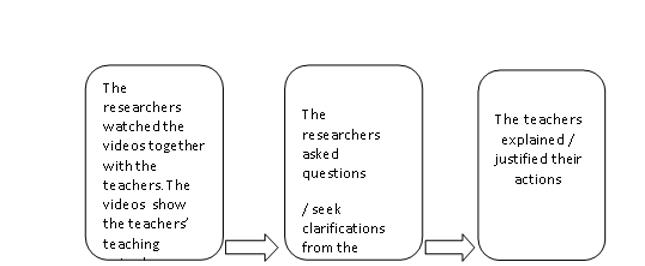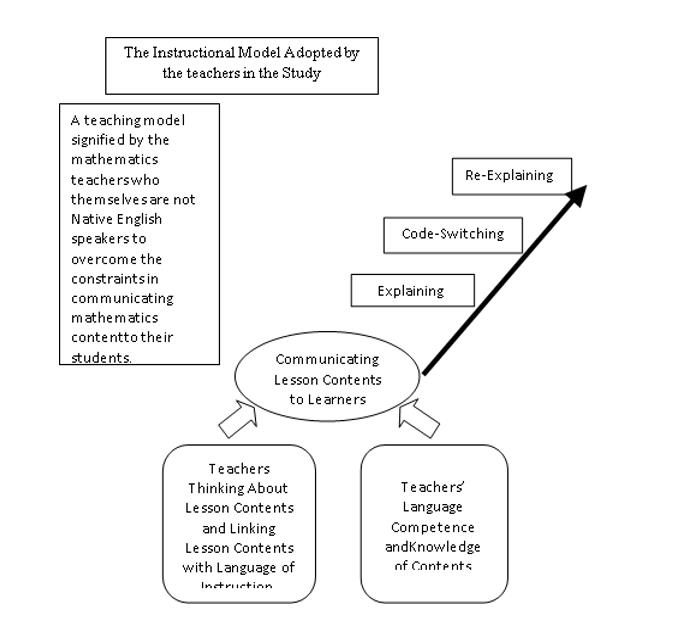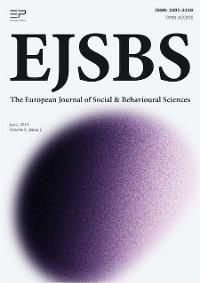Abstract
Change in the medium of instruction for Mathematics in schools policy was deemed necessary to ensure that Malaysians are able to keep abreast with scientific and technological development that is mostly recorded in the English language. This change of the medium of instruction may affect the dynamics of teaching and learning Science and Mathematics in the multilingualism classroom. In this paper we draw on our research projects in Malaysia to describe and discuss the oral competencies, communication and discourse practices of secondary school mathematics teachers when delivering the lesson content using English as the medium of instruction. Qualitative data was obtained via interviews with the teachers and the students, as well as observations of teachings episodes encapsulated within video recordings and the employment of retrospective techniques to understand teachers’ actions and explanations of mathematics lesson content. Through our descriptions and discussion, we argue that while at a general pedagogical level it makes sense for teachers to be encouraged and use code-switching as learning and teaching strategy because teaching mathematics lesson content to learners whereby English is not their mother-tongue language is not a straight forward matter. We suggest a teaching model signified by these mathematics teachers, who themselves are not native English speakers, to overcome the challenges in communicating mathematics content to their students. Furthermore, we show how the movement across mathematical discourses relates to movement between languages in classroom communication and the quality of mathematics teaching and learning that had resulted.
Keywords: Oral competencies, multilingualism, non-native speaker, language and mathematics, discourse analysis, classroom communication
Introduction
Beginning 2003, in the national school, English was re-adopted as the medium of instruction for Science and Mathematics after about 33 years of using Malay (Bahasa Melayu). This change in the medium of instruction for Science and Mathematics in schools policy was deemed necessary to ensure that Malaysians are able to keep abreast with scientific and technological development that is mostly recorded in the English language. At the same time, this move is envisioned to provide opportunities for students to use the English Language and therefore increase their proficiency in the language (Sharifah Maimunah Syed Zin, 2002). Although the implementation of the teaching of Mathematics and Science came armed with training provisions for teachers, such as the Teaching of Mathematics and Science (EteMs) programme, comments are heard from teachers regarding problems with the implementation. This change of the medium of instruction may affect the dynamics of teaching and learning Science and Mathematics in the classroom. Students seem to have problems understanding terms used and they seem to be unmotivated, and lessons seemed to have become unattractive and appealing (Harshita, 2005).
Code switching
It is observed that the language in which education is conducted is very important as the selected language may enhance or impede the quality of education. Therefore, language is an important issue, especially in multilingual classrooms where we have students from different linguistic and socio-cultural backgrounds. The language of instruction can also be a problem, especially when the content or concepts being taught are not in the learners’ home language. Learning certain subjects, such as Mathematics, in English may be a problem for students whose home language is not English. Learning such subjects in the students’ home language or supplementing English with the students’ home language (code switching) can lead to a better understanding of the contents being taught. Hoffman (1991) view code switching as a communication strategy and it is the situation in which two languages are used in the same utterance. For bilinguals or trilinguals it is normal to move between different languages when talking with each other, and code switching is an essential strategy for them. Therefore, learners are not treated as unsuccessful monolinguals in each language, but rather as people who possess and manipulate more than one grammatical system; elements from these systems come into contact on a regular basis, and the speakers combine them in ways congruent with each language, but also reflecting unique properties specific to the code-switching situation.
Talk in the Classroom
Talk in the classroom involves the talk of the teacher and the talk of the learners, and, as in any relationship, the one can have a deep impact on the other, for better or worse (Hendersen & Wellington, 1998). In the instruction of mathematics, paying to (mathematical) language is important because it is a dimension that is quite pertinent to classroom operations (Rubenstein & Thompson, 2000). Hence, it is deemed significant that teachers have to give due attention to mathematical language learning as the opportunity for students to “talk mathematics” is very much confined to the mathematics classrooms (Thompson & Rubenstein, 2002). It seems uncontroversial that the nature of classroom discourse influences learning (Hiebert & Wearne, 1993). “The kind of talk in which the teacher and students engage must have some effect on learning” (Hiebert & Wearne, 1993, p. 396).
Problem Statement
Classrooms undoubtedly play a significance role as a setting for students to encounter formal mathematical knowledge since the Malaysian students significantly learn Mathematics within formal classrooms (Ruzlan, 2006). The instruction of mathematics in English, the non-native language both for the mathematics teachers and the students, has placed great linguistic demands on teachers of the two subjects, who, for most, had been teaching these subjects in Malay throughout their teaching careers (Harshita & Arsaythamby, 2007). There seems to be a link between teachers’ indications in classrooms and students’ construal and knowledge of mathematics (Ruzlan, 2006). Teachers teach through the medium of language. Hence, language is a major means of communication within classrooms. Students construct understanding as they process ideas through language. Academic language is found in schools (e.g., teachers’ lectures, known-answer questioning between teacher and students), in textbooks, and in discussions about abstract ideas—in any language; it is use in academic spoken and written discourse, for communicating information pertaining to the lesson content, as well as for academic activities such as analyzing, explaining, justifying, and evaluating content ideas and processes (Solomon & Rhodes, 1995). The teaching and learning of science depends on the level of students’ language-mastering in terms of all its aspects and components: in terms of communication effectiveness, which is based on the understanding of the literal meaning of what is explained by the teacher or by sources like textbooks or other materials. Perhaps, a similar communicative situation takes place in the learning of other subjects in schools, including mathematics.
Research Questions
The central question that guided the study was how do the mathematics teachers communicate the lesson content when the medium of instruction is a non-native language to them and how receptive are the students when a non- native language was used in their mathematics classrooms?
Purpose of the Study
The general purpose of the study was to explore not only how language and mathematics interacts, but also how teachers explain mathematics in a multilingual context. The purpose of this paper is to provide an indication of what the teachers had managed to communicate and explain the subjects’ content. In a sense, this paper purports to provide a glimpse into the teachers’ utterances and the words they had used when delivering the lesson contents in classrooms.
Research Methods
The study had adopted a multiple case design. Qualitative methods employed involved the stimulated recall technique as well as interviews. Within these methods, the teachers in the study were asked to describe their instructional approaches adopted by them as well as the effectiveness of their instructions. Students were also purposively selected for interviews so as to capture the effectiveness of the instructions which used the non-native speaker language the learners’ perspective.
The Stimulated Recall (Retrospective) Session
In brief, six (6) research participants (teachers) and the researchers met as a group. Six (6) sessions were held altogether in which one session was for one teacher. The duration for each session was between 3-4 hours. The stimulated recall session was carried out within three months. Figure 1 shows the process of stimulated recall session carried out within the current study.

The Research Participants
The purposively selected research participants comprised of five secondary school mathematics teachers and 135 secondary school students which were from four different national secondary schools in one education district in a northern state in Malaysia. The teachers teaching experience ranged from 3 years to 15 years and the students’ age ranged from 14 years to 16 years.
Findings
Below is an excerpt taken from the teaching episode of one of the mathematics teacher in the current study. This excerpt provides a glimpse of how the mathematics teacher explains the lesson content to his students. The topic taught was ‘Simultaneous Equation’.
“…Ada a, b, c … oh ini (teacher points to the whiteboard)... y = x²- 3x +5 )…a, b, c. Ok …kalau tengok di sini (points to the LCD screen) boleh kita nampak perbezaan dia…dalam ni kan…sekarang kita tengok yang tingkatan tiga dulu…y equal…y equal x plus two…kita masukkan function di sini…x plus 2, x plus two…aaa nampak…inilah line dia…x plus 2…itu yang equation yang pertama…ok…cuba kita yang kedua pulak…4x minus, use 4 times x…times x kemudian minus four…aaa tu equation dia…ok…kita dapati yang kita belajar di peringkat Form Three melibatkan dua straight lines…lepas tu kita solve simultaneous equations tu akhirnya kita nak dapat apa?…akhirnya kita nak cuba dapatkan ni… coordinate of intersection…ok…cuba kita tengok dia punya coordinate dia (teacher points to the coordinate of intersection on the whiteboard – projected on the board using LCD) …dua…empat…kalau nak jelas lagi…kita tengok coordinate of intersection…ha tu dia! (teacher points to the coordinate of intersection)… coordinate of intersection dia! …dua…empat, x dia dua y dia ?…”
It can be seen that within this excerpt, the teacher’s explanation was carried out using both the Malay language and English in an interweaving manner. Nevertheless, seemingly, the use of English was more of restating the ‘terminologies’ within the subject (e.g., ‘equal’, ‘plus’, ‘equation’, ‘coordinate”, etc.), but not used for the purpose of explaining the steps or procedures in solving the mathematics questions.
Interview question: In your view, how effective is your explanation of mathematics concepts in the classroom?
The responses of the mathematics teachers to the above interview question are presented in the form of cases as below:
The case of MZS
He seemingly had no problem in explaining the mathematics concepts. He answered, “I am able to explain the concepts clearly to the students”. However, according to him, it is insufficient to solely depend on the explanation given in English, and it is not effective. He pointed out the need to “reinforce the explanation by using Malay”. [He seems to support code-switching as a technique/strategy to help students understand the mathematics lesson content]. He further added that, “at times I have to spend so much time to repeat my explanation so that my students can understand what I am trying to tell them. I repeat in Malay. However, I retain the mathematical terms in English”.
The case of MSQ
MSQ pointed out there are some students that he taught who were not able to understand the content because “they are poor in English”. Even though “these students can understand the concepts and ideas discussed in the classroom, nevertheless I still need to explain further in Malay…it has to be bilingual. MSQ also feels that “repetition is very much necessary when we teach students with poor English background…and we have to repeat a few times so that they can comprehend the lesson content”.
The case of MMM
To MMM, he is moderately able to explain the mathematics concepts in English. He added that, “there is always a need to give examples in Malay so that my students can better understand what I am saying”.
The case of MHA
MHA feels that using English to explain the mathematics concepts is less effective because “I need to repeat myself using the mother tongue language”.
The case of FSY
FSY reported that “when I explained 100% in English, I found that my students were rather slow to understand the mathematics concept that I am teaching”. According to her, “even though mathematics involve numbers, explaining mathematics concepts is very important because students understanding can be evaluated through their understanding of the concepts.” She further mentioned “there is a group of students who can easily and quickly understand…and can show excellent and systematic steps of solving questions.” However, “there are students who are rather slow to understand and they need individual guidance from the teacher”.
Students’ Views
The students were also interviewed and one of the questions asked during the interview was their view regarding the choice of using English or Malay language (Bahasa Melayu) as the medium of instruction in the mathematics classrooms. Below is an excerpt from one of the interviews which provides a glimpse into an interview session between the researcher and one of the students who were selected for the interview:
Interviewer: Your teacher used English more or Malay language more?)
Student: Equally! (Sama-sama banyak).
Interviewer: How does the teacher write on the board? Student:In English!
Inteviewer: What if the teacher only use English? Student:Cannot!
Interviewer: What if the teacher teaches fully in English? Student: Ooo..Cannot!...totally cannot! we are finish!!!
Interviewer: Must use Malay too?
Student: Cannot only in English….not too direct! After all we are Malay people!
From the above excerpt, it can be seen that the student interviewed had indicated a non-receptive feelings when asked whether or not he approves if mathematics is fully taught in English, in a language that is not his mother tongue language and taught by a non-native speaker of the language. By saying that “we are finish!”, seemingly he was indicating the outcomes of his mathematics learning when the lesson content is fully taught in a non-native language, a language which he was not competence in, and obviously finds difficult to comprehend.
Participants
The participants (n=22) were 7 trainers and altogether 15 country directors and other LQ administrators representing 15 different countries. Half of the participants were female. About two-thirds of the participants came from a country where LQ had been implemented for over 10 years, and one-third represented a country where LQ had been implemented during the last few years. Over 40% of the participants had over five years of experience of conducting LQ, and about 30% had one to five years of experience. About 30% were newcomers having less than one year’s experience of LQ.
Conclusions
Teachers in the schools used code switching, as an approach, when explaining to ensure the acquisition of mathematics content and knowledge seemingly because by using this approach, each student is allowed to use his/her languages in a natural, meaningful way while the various classroom activities were being implemented. The study concluded that the use of code switching when communicating mathematical knowledge, within multilingual mathematics classrooms, would not resulted in a deficiency of learning the subject content, but instead is a useful strategy in classroom interaction and an efficient way of transferring knowledge to students. In a sense, as visible within the findings of this study, code switching was employed to meet the classroom communicative and linguistic needs because the choice of appropriate words, or lack of appropriate expressions, was due to different cultural values. Hence, it can be said that, the movement across mathematical discourses relates to movement between languages during communication that takes place in classrooms, inevitably effected the quality of mathematics teaching and learning of mathematics in the classrooms. The suggested teaching model which the mathematics teachers seemingly had adopted when communicating the lesson content in their mathematics classrooms using a non-native language is as shown in Figure 2.

The Way Forward
Code switching should be allowed as a teaching strategy in bilingual / multilingual classrooms since it has the potential to enhance communication to support the class participants in striving to relate their thoughts to others who had varying proficiencies in not only English but in their mother tongue language as well. In the interactions between teachers and students, code switching could be tailored to function as a communicative strategy to clarify or reinforce the teacher’s points – hence overcoming the gap of linguistic competence among the students in the two languages used during classroom instruction.
Acknowledgements
This study was partially funded by the project RYM Indoors Environment 462054 of the Finnish Funding Agency for Technology and Innovation. We would also like to thank Lions Clubs International Foundation and Ulla Savolainen for their contribution to this manuscript.
References
Harshita Aini Haroon. (2005). Teacher code-switching and its functions in Mathematics and Science lessons. Asia-Pacific Journal of Language in Education, 7(1), 1-25.
Harshita Aini Haroon & Arsaythamby Veloo. (2007). Content-based instruction in the Malaysian context: What challenges do teachers face? In A. Pandian, Koo Yew Li, & P. Kell (Eds.), Innovation and Intervention in ELT (pp. 183-197). Serdang: UPM Press.
Hoffmann, C. (1991). An Introduction to Bilingualism. London: Longman
Henderson, J., & Wellington, J. J. (1998). Lowering the language barrier in learning and teaching science. School Science Review, 79(288), 35-46.
Hiebert, J., & Wearne, D. (1993). Instructional tasks, classroom discourse, and students’ learning in second-grade arithmetic. American Educational Research Journal, 30(2), 393-425. DOI:
Rubenstein, R., & Thompson, D. (2002). Understanding and supporting children's mathematical vocabulary development. Teaching Children Mathematics, 9(2), 107-112. DOI:
Ruzlan Md-Ali. (2006). Teachers’ Indication and Pupils’ Construal and Knowledge of Fractions: The Case of Malaysia. Unpublished Ph.D Thesis, University of Warwick, United Kingdom.
Sharifah Mahmud Syed Zin. (2002). Preface. Curriculum Specifications, Science Form One. Kuala Lumpur: CDC, Ministry of Education.
Solomon, J., & Rhodes, N. C. (1995). Conceptualizing academic language. Washington, D.C.: National Center for Research on Cultural Diversity and Second Language Learning.
Thompson, D. R., & Rubenstein, B. N. (2000). Learning Mathematics vocabulary: Potential pitfalls and instructional strategies. The Mathematics Teacher, 93(7), 568-574. DOI:
Copyright information

This work is licensed under a Creative Commons Attribution-NonCommercial-NoDerivatives 4.0 International License.


